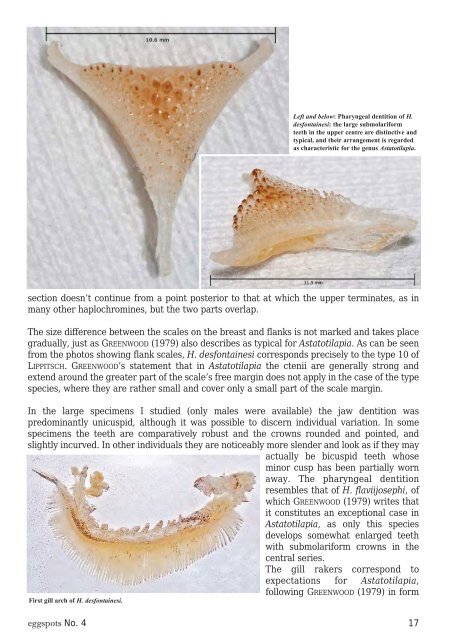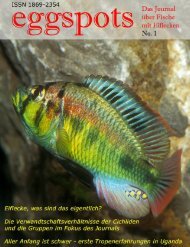Eggspots Elsewhere - Welt der Fische / World of Fishes
Eggspots Elsewhere - Welt der Fische / World of Fishes
Eggspots Elsewhere - Welt der Fische / World of Fishes
Create successful ePaper yourself
Turn your PDF publications into a flip-book with our unique Google optimized e-Paper software.
section doesn’t continue from a point posterior to that at which the upper terminates, as in<br />
many other haplochromines, but the two parts overlap.<br />
The size difference between the scales on the breast and flanks is not marked and takes place<br />
gradually, just as GREENWOOD (1979) also describes as typical for Astatotilapia. As can be seen<br />
from the photos showing flank scales, H. desfontainesi corresponds precisely to the type 10 <strong>of</strong><br />
LIPPITSCH. GREENWOOD’s statement that in Astatotilapia the ctenii are generally strong and<br />
extend around the greater part <strong>of</strong> the scale’s free margin does not apply in the case <strong>of</strong> the type<br />
species, where they are rather small and cover only a small part <strong>of</strong> the scale margin.<br />
In the large specimens I studied (only males were available) the jaw dentition was<br />
predominantly unicuspid, although it was possible to discern individual variation. In some<br />
specimens the teeth are comparatively robust and the crowns rounded and pointed, and<br />
slightly incurved. In other individuals they are noticeably more slen<strong>der</strong> and look as if they may<br />
actually be bicuspid teeth whose<br />
minor cusp has been partially worn<br />
away. The pharyngeal dentition<br />
resembles that <strong>of</strong> H. flaviijosephi, <strong>of</strong><br />
which GREENWOOD (1979) writes that<br />
it constitutes an exceptional case in<br />
Astatotilapia, as only this species<br />
develops somewhat enlarged teeth<br />
with submolariform crowns in the<br />
central series.<br />
The gill rakers correspond to<br />
expectations for Astatotilapia,<br />
following GREENWOOD (1979) in form<br />
First gill arch <strong>of</strong> H. desfontainesi.<br />
eggspots No. 4<br />
Left and below: Pharyngeal dentition <strong>of</strong> H.<br />
desfontainesi: the large submolariform<br />
teeth in the upper centre are distinctive and<br />
typical, and their arrangement is regarded<br />
as characteristic for the genus Astatotilapia.<br />
17




